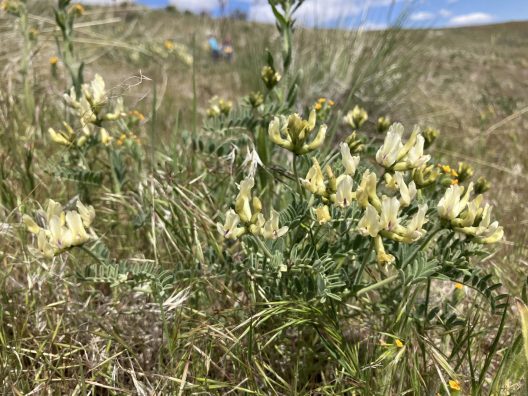Habitat Restoration for Climate Resilience
Along the rutted road to Colockum Creek Area of Critical Environmental Concern (ACEC), remnant patches of 7-foot-tall big sagebrush (Artemisia tridentata) give a glimpse of what the ACEC might have looked like before
recent wildfires. Today, most of the site is covered by a near-monoculture of nonnative cheatgrass (Bromus tectorum) and tumble mustard (Sisymbrium altissimum) because the site has burned three times since 2013.
Fires used to burn sagebrush steppe ecosystems in Washington every 30-70 years, not every 3-4, but cheatgrass is a fierce and flammable competitor. It shortens the amount of time between wildfires, making it difficult for native species to reestablish, especially fire-intolerant species like big sagebrush.
Bureau of Land Management’s Colockum Creek ACEC is managed for the state endangered Whited’s milkvetch (Astragalus sinuatus), which is endemic to a 6-square-mile area near Wenatchee. While Whited’s milkvetch can survive fires, its seedlings struggle to establish when there is dense competition with cheatgrass.

That’s why Rare Care’s 2025 Habitat Restoration Plan recommends restoration of a native plant community that can reestablish quickly after wildfires to prevent cheatgrass invasion. Recommended species include bluebunch wheatgrass (Pseudoroegneria spicata), balsamroot species (Balsamorhiza spp.), and common rabbit-brush (Ericameria nauseosa) — a shrub that resprouts from its crown after fire.
Notably absent from our recommended species list is big sagebrush, despite its historical abundance. Shorter fire intervals are predicted to continue at Colockum Creek, and big sagebrush does not resprout after fires. Repeated restoration efforts would be required to reestablish big sagebrush after each subsequent fire, since it would take years to return naturally. Our expectation is that restoring the fire-prone site with species that can resprout after fire will help resist future cheatgrass infestations, help more Whited’s Milkvetch seedlings survive, and create a more resilient native plant community.
The restoration plan is the first part of what we expect will be a multi-phased “staged scale restoration” approach. Staged scale restoration involves restoring increasingly large areas while testing different restoration techniques, with each stage comparing the best methods from the previous stage until the optimal method is found. For the next phase of restoration, we recommend testing one to two different herbicides in combination with planting and seeding native species. Herbicide will help reduce the cheatgrass population for long enough to help planted and seeded native species establish.
Although restoring more heavily with fire-tolerant native species may result in a community that differs from the historical state, an adaptable management approach will help ensure this ecosystem has the resilience to support Whited’s milkvetch in a changing climate.